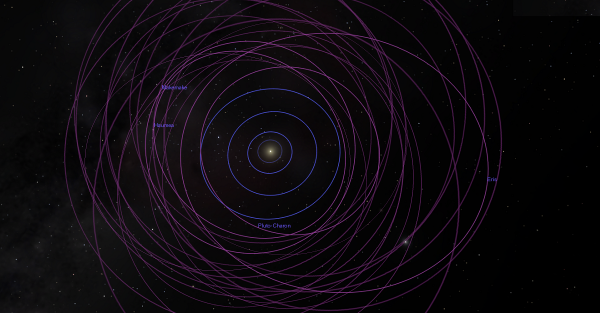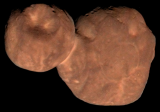BY LETTER
Kuiper Belt
 Image from Steve Bowers |
In the Solar System, the Kuiper Belt is a sparse belt of icy objects beyond Neptune, but closer than the Oort cloud; from around 20 AU to around 50 AU from the Sun. The Kuiper belt was named for the Dutch-American astronomer Gerard P. Kuiper, who predicted its existence in 18 BT. Objects found in the Kuiper Belt include a number of cold dwarf planets such as Pluto, Haumea, and Makemake, and smaller objects such as Ixion and Arrokoth.
Some of these objects were colonised in the late Interplanetary Age by a group known as the Haloers, but these were later joined by refugees from the Technocalypse and the Great Expulsion. Some of the Hiders who remained on these worlds were contacted after the Dark Age and joined the First Federation, while others moved further out to the Oort cloud and beyond.
For details about the Kuiper Belt in the Current Era, see here.
Extrasolar Kuiper Belts
In general, any belt beyond the outermost large planet of a solar system but closer than the local Oort cloud is considered to be a Belt. The characteristics of such belts are dependent on the history of the star and its system of planets, as well as its arity; many stars have no Kuiper belt, and some have two or more. Many Kuiper belt objects have been perturbed significantly by other stars and objects passing nearby, while some retain their original orbital characteristics.Related Articles
- Backgrounders
- Haloers, Haloists
- Kuiperian Type Planetoid
- Oort Cloud
- Oort Vault - Text by Anders Sandberg
Data storage systems on the edge of a solar system, holding inactive data in storage for future use. A common repository for inactive virch entities, planetary archives and long range statistics.
Appears in Topics
Development Notes
Text by M. Alan Kazlev
additional material by Steve Bowers
Initially published on 29 November 2001.
Updated 2025-05-02 by AstroChara: Updated Arrokoth's name. Also, Eris is not a "smaller object".
additional material by Steve Bowers
Initially published on 29 November 2001.
Updated 2025-05-02 by AstroChara: Updated Arrokoth's name. Also, Eris is not a "smaller object".







